Suzuki GSX-R 1000 Service Manual: Clutch installation
- Install the primary driven gear assembly (1).
Caution
|
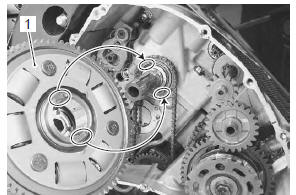
- Install the spacer (2) and bearing (3), and apply engine oil to them.
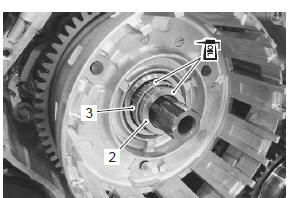
- Install the thrust washer (4).
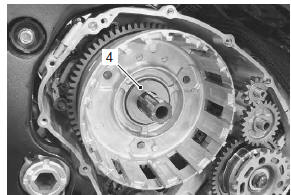
- Install the seat washer (5) to the clutch sleeve hub (6).
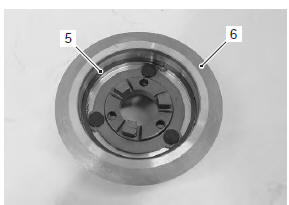
- Install the wave spring washers (7) and clutch lifter driven cam (8).
- Apply engine oil to the contacting surfaces of the clutch sleeve hub, clutch lifter drive cam and clutch lifter driven cam.
- Install the clutch lifter drive cam (9).
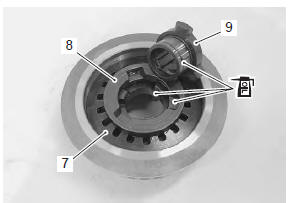
- Install the clutch sleeve hub, washer (10) and spring washer (11).
| Note the conical curve side of spring washer (11) faces outside. |
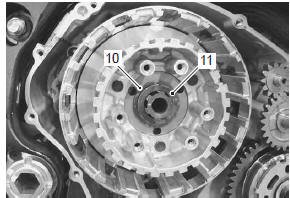
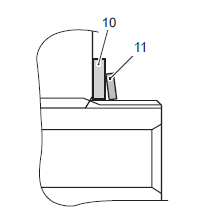
- Hold the clutch sleeve hub with the special tool.
Special tool
 (a): 09920–53740 (clutch sleeve hub
(a): 09920–53740 (clutch sleeve hub
holder)
- Tighten the clutch sleeve hub nut to the specified torque.
Tightening torque clutch sleeve hub nut (a): 95 n·m (9.5 Kgf-m, 68.7 Lbf-ft)
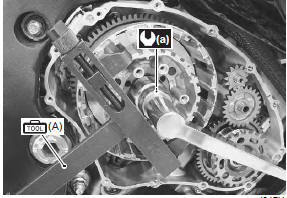
- Lock the clutch sleeve hub nut with a center punch.
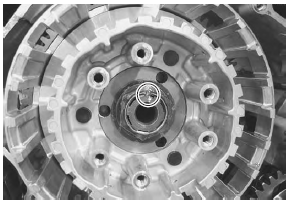
- Install the clutch push rod (12) into the countershaft.
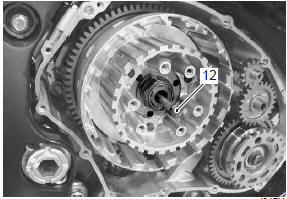
- Install the clutch push piece (13), bearing (14) and thrust washer (15) to the countershaft.
| Note thrust washer (15) is located between the pressure plate and bearing (14). |
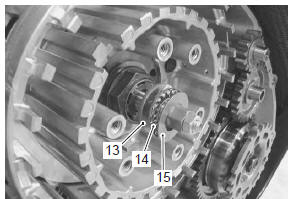
- Install the spring washer seat (16) and spring washer (17) onto the clutch sleeve hub correctly.
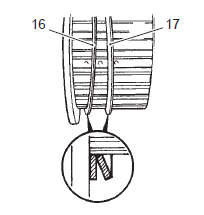
- Apply engine oil to the clutch drive plates.
- Insert the clutch drive plates and driven plate one by one into the clutch sleeve hub in the prescribed order.
| Note insert the outermost no. 1 Drive plate claws “a” to the other slits “b” of clutch housing as shown in the figure. |
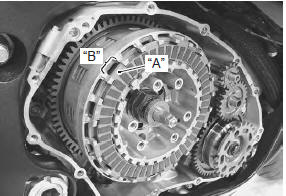

|
| Note two kinds of drive plate (no. 1 And no. 2) Are equipped in the clutch system, they can be distinguished by inside diameter. |

| Note three kinds of the driven plate (no. 1, No. 2 And no. 3) Are equipped in the clutch system, they can be distinguished by color and thickness. The no. 1, No. 2 And no. 3 Driven plates are 8 pcs. In total. 5 – 7 Pcs. Of no. 1 Driven plates are used with 1 pc. Of no. 2 And 0 – 2 pc(-s). Of no. 3 Driven plate(-s) as a set. The no. 3 Driven plate(-s) should be installed in pressure plate side. |

- Install the pressure plate (23).
| Note when install the pressure plate, fit the convex part “d” of the pressure plate onto the concave part “e” of the clutch sleeve hub. |
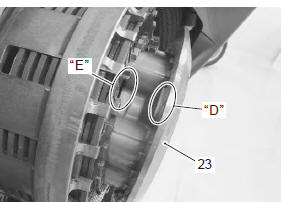
- Install the clutch springs and set bolts.
- Tighten the clutch spring set bolts to the specified torque.
Tightening torque clutch spring set bolt: 10 n·m (1.0 Kgf-m, 7.0 Lbfft)
| Note tighten the clutch spring set bolt little by little and diagonally. |
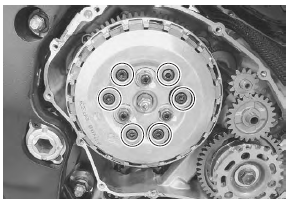
- Loosen the lock-nut (24) and turn in the clutch release adjusting screw (25) until resistance is felt.
- From that position, turn out the clutch release adjusting screw (25) 1 turn and tighten the lock-nut (24) while holding the screw (25).
Tightening torque clutch release adjusting screw lock-nut: 6 n·m ( 0.6 Kgf-m, 4.5 Lbf-ft)
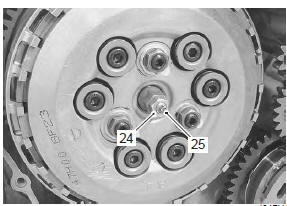
- Apply bond lightly to the mating surfaces at the parting line between the upper and lower crankcases as shown in the figure.
 : Sealant 99000–31140 (suzuki
: Sealant 99000–31140 (suzuki
bond
no.1207B or equivalent)
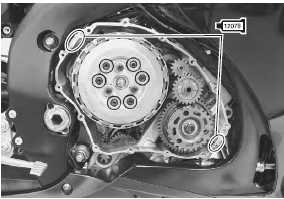
- Install the dowel pins and new gasket (26).
| Caution use new gasket to prevent oil leakage. |
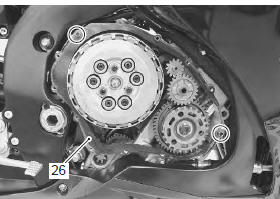
- Apply bond lightly to the ckp sensor grommet.
 : Sealant 99000–31140 (suzuki
: Sealant 99000–31140 (suzuki
bond
no.1207B or equivalent)
- Apply molybdenum oil solution to the starter torque limiter/idle gear no. 2 Shaft holes.
M/o: molybdenum oil (molybdenum oil solution)
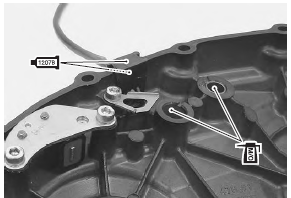
- Install the clutch cover and tighten the clutch cover bolts.
| Note fit new gasket washer to the bolt “f” and clamp to the bolt “g”. |
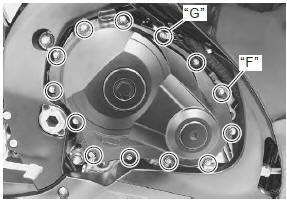
- Route the ckp sensor lead wire properly. Refer to “wiring harness routing diagram” in section 9a .
- ) Install the fuel tank. Refer to “fuel tank removal and installation” in section 1g .
- Pour engine oil. Refer to “engine oil and filter replacement” in section 0b .
 Clutch removal
Clutch removal
Drain engine oil. Refer to “engine oil and filter replacement” in
section 0b .
Lift and support the fuel tank with the prop stay.
Refer to “fuel tank removal and installation” in secti ...
 Clutch parts inspection
Clutch parts inspection
Refer to “clutch removal” and “clutch installation” .
Clutch drive and driven plate
Note
wipe off the engine oil from the drive and
driven plates with a clean rag.
Measure t ...
Other materials:
Starter clutch inspection
Refer to “starter clutch removal and installation” .
Starter clutch
Install the starter driven gear onto the starter clutch.
Turn the starter driven gear by hand to inspect the
starter clutch for a smooth movement. The gear
turns in one direction only. If a large resistance is felt
...
Cushion rod bearing removal and installation
Removal
Remove the cushion rod. Refer to “cushion rod removal and installation”
.
Remove the cushion rod bearing with the special
tool.
Special tool
(a):
09921–20240 (bearing remover set)
Installation
Caution
the removed bearings must be replaced with
new on ...
Gearshift shaft oil seal / bearing removal and installation
Removal
Remove the gearshift shaft. Refer to “gearshift shaft / gearshift cam
plate removal and installation” .
Remove the gearshift shaft oil seal (1).
Remove the bearings (2) and (3) with the special
tools.
Special tool
(a): 09921–20210 (bearing remover
(12
mm))
...
